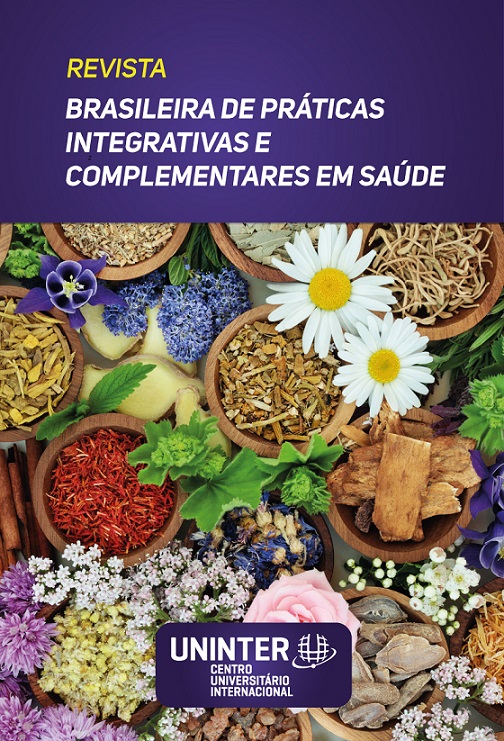Potencial terapêutico do quimiotipo II da Lippia alba (Mill.) N. E. Brown - citral-limoneno: uma revisão integrativa
Keywords:
Lippia alba, Quimiotipo II, Ação terapêuticaAbstract
A Fitoterapia é uma Prática Integrativa e Complementar que abrange o uso terapêutico de plantas medicinais, derivados vegetais e fitoterápicos e, devido à importância das plantas medicinais no contexto da Atenção Primária à Saúde, foi criada a Relação Nacional de Plantas Medicinais de Interesses no Sistema Único de Saúde (ReniSUS), composta por 71 espécies, dentre elas a Lippia alba. A erva-cidreira é amplamente utilizada no Brasil por suas propriedades calmantes, analgésicas e sedativas. O quimiotipo II (citral e limoneno) é empregado em diferentes usos terapêuticos, como ação sedativa e ansiolítica. Assim, o presente estudo propõe investigar o potencial terapêutico do quimiotipo II da L. alba. Para esta revisão de literatura, utilizou-se a expressão de busca: ("Lippia alba" OR "Carmelite cider") AND Pharmacology, nas bases de dados: BVS, PubMed, Web of Science e ScienceDirect. Foram incluídos artigos entre o período de 2013 a 2023 em português e inglês e que respondessem à pergunta norteadora. Foram selecionados 7 artigos que investigaram as ações da L. alba quanto suas ações terapêuticas. Dois estudos analisaram o efeito vasorelaxante do Óleo Essencial da L. alba (OELa) e seus constituintes majoritários, citral e limoneno na musculatura lisa de ratos, em que se percebeu um relaxamento significativo dependente de sua concentração no tratamento com OELa. Um dos estudos avaliou a atividade antiparasitária do OELa e do citral, e notou-se que houve a redução da viabilidade do Schistosoma mansoni. Outro estudo observou a atividade antiproliferativa em células cancerígenas da linhagem do cólon, no qual o OELa foi capaz de induzir paradas no ciclo celular. Foi possível observar, em um outro estudo, que avaliou o efeito nefroprotetor do quimiotipo citral-limoneno do óleo essencial de L. alba, a recuperação da estrutura morfológica das células tubulares após reperfusão isquêmica. Com base nos estudos apresentados, é possível concluir que a erva-cidreira demonstra diversos potenciais terapêuticos. Entretanto, ressalta-se a necessidade de pesquisas contínuas para aprofundar o entendimento das propriedades da L. alba, de forma a contribuir com o seu uso seguro e eficaz em diversas patologias.
Palavras-chave: lippia alba; quimiotipo II; ação terapêutica.
Abstract
Phytotherapy is an integrative and complementary practice that encompasses the therapeutic use of medicinal plants, plant derivatives, and phytotherapics. Given the importance of medicinal plants in the context of primary health care, the National List of Medicinal Plants of Interest in the Unified Health System (ReniSUS) was created, comprising 71 species, including Lippia alba. Lemon balm is a widely utilized plant in Brazil, particularly for its calming, analgesic, and sedative properties. Chemotype II (citral and limonene) has been demonstrated to possess therapeutic properties, including sedative and anxiolytic actions. The objective of this study is to investigate the potential therapeutic applications of chemotype II of Lippia alba. In conducting this literature review, the search expression utilized was "Lippia alba" OR "Carmelite cider" AND Pharmacology across the following databases: BVS, PubMed, Web of Science, and ScienceDirect. Articles published between 2013 and 2023 in either Portuguese or English that addressed the guiding question were included. Seven articles were selected for analysis to investigate the therapeutic actions of L. alba. Two studies were conducted to analyze the vasorelaxant effect of L. alba essential oil (OELa) and its main constituents, citral and limonene, on the smooth musculature of rats. The results demonstrated a significant relaxation in a concentration-dependent manner after treatment with OELa. One study evaluated the antiparasitic activity of OELa and citral, which demonstrated the ability to reduce the viability of Schistosoma mansoni. Another study observed antiproliferative activity in colon cancer cells, wherein OELa was demonstrated to induce cell cycle arrest. In a separate investigation into the nephroprotective impact of the citral-limonene chemotype of L. alba essential oil, it was demonstrated that tubular cells could recuperate their morphological structure following ischemic reperfusion. Considering the evidence presented in the studies, it can be concluded that lemon balm has a range of therapeutic potential. Nevertheless, further research is required to gain a deeper understanding of the properties of L. alba, with the aim of ensuring its safe and effective use in the treatment of various pathologies.
Keywords: lippia alba; chemotype II; therapeutic action.
Resumen
La Fitoterapia es una Práctica Integrativa y Complementaria que abarca el uso terapéutico de plantas medicinales, derivados vegetales y fitoterápicos y, debido a la importancia de las plantas medicinales en el contexto de la Atención Primaria a la Salud, se creó la Relación Nacional de Plantas Medicinales de Interés en el Sistema Único de Salud (ReniSUS), compuesta por 71 especies, entre ellas la Lippia alba. La verbena de limón es ampliamente utilizada en Brasil por sus propiedades calmantes, analgésicas y sedantes. El quimiotipo II (citral y limoneno) se emplea en distintos usos terapéuticos, como acción sedante y ansiolítica. Así, el presente estudio propone investigar el potencial terapéutico del quimiotipo II de la L. alba. Para esa revisión de literatura, se utilizó la expresión de búsqueda: (“Lippia alba” OR “Carmelite cider”) AND Pharmacology, en las bases de datos: BVS, PubMed, Web of Science y ScienceDirect. Se incluyeron artículos entre el período de 2013 a 2023 en portugués e inglés y que respondieran a la pregunta orientadora. Se seleccionaron 7 artículos que investigaron las acciones de L. alba en cuanto a sus acciones terapéuticas. Dos estudios analizaron el efecto relajante vascular del Aceite Esencial de L. alba (OELa) y sus constituyentes mayoritarios, citral y limoneno, en la musculatura lisa de ratas, en las que se observó una relajación significativa dependiente de su concentración en el tratamiento con OELa. Uno de los estudios evaluó la actividad antiparasitaria del OELa y el citral, y se observó que hubo una reducción en la viabilidad de Schistosoma mansoni. Otro estudio observó la actividad anti proliferativa en células cancerosas de la línea del colon, en el que el OELa fue capaz de inducir paradas en el ciclo celular. Fue posible observar, en otro estudio, que evaluó el efecto nefro protector del quimiotipo citral-limoneno del aceite esencial de L. alba, la recuperación de la estructura morfológica de las células tubulares tras reperfusión isquémica. Basado en los estudios presentados, es posible concluir que la verbena de limón demuestra varios potenciales terapéuticos. Sin embargo, se destaca la necesidad de investigaciones continuas para profundizar el conocimiento de las propiedades de L. alba, a fin de contribuir con su uso seguro y eficaz en diversas patologías.
Palabras clave: Lippia alba; quimiotipo II; acción terapéutica.
Downloads
References
BADAWY, M. E. et al. Antimicrobial and antioxidant activities of hydrocarbon and oxygenated monoterpenes against some foodborne pathogens through in vitro and in silico studies. Pesticide Biochemistry and Physiology, [s. l.], v. 158, p. 185-200, 2019. DOI: https://doi.org/10.1016/j.pestbp.2019.05.008. Disponível em: https://www.sciencedirect.com/science/article/abs/pii/S0048357519301142?via%3Dihub. Acesso em: 08 dez. 2023.
BARBOSA, F. G. Contribuição ao conhecimento químico de três quimiotipos de Lippia alba (Mill.) N. E. Brown cultivados no Horto de Plantas Medicinais da UFC. 2003. 324 f. Tese (Doutorado em Química Orgânica) — Universidade Federal do Ceará, Fortaleza, 2003. Disponível em: https://repositorio.ufc.br/handle/riufc/71742. Acesso em: 08 dez. 2023.
BRASIL. Relação Nacional de Plantas Medicinais de Interesse ao Sistema Único de Saúde. Brasília: Ministério da Saúde, 2009. Disponível em: https://www.gov.br/saude/pt-br/composicao/sectics/daf/pnpmf/ppnpmf/renisus.
BRASIL. Resolução – RDC n.º 26, de 13 de maio de 2014. Dispõe sobre o registro de medicamentos fitoterápicos e o registro e a notificação de produtos tradicionais fitoterápicos. Diário Oficial da União: seção 1, Brasília, DF, v. 152, n.º 90, p. 52-61, 14 mai. 2014. Disponível em: https://pesquisa.in.gov.br/imprensa/jsp/visualiza/index.jsp?data=14/05/2014&jornal=1&pagina=1&totalArquivos=100. Acesso em: 08 dez. 2023.
BRAUN, C. J. et al. P53-responsive microRNAs 192 and 215 are capable of inducing cell cycle arrest. Cancer Research, [s. l.], v. 68, n. 24, p. 10094-10104, 2008. DOI: https://doi.org/10.1158%2F0008-5472.CAN-08-1569. Disponível em: https://aacrjournals.org/cancerres/article/68/24/10094/541795/p53-Responsive-MicroRNAs-192-and-215-Are-Capable. Acesso em: 08 dez. 2023.
BROWN, J. et al. Whole-Cell Patch-Clamp Recording of Voltage-Sensitive Ca2+ Channel Currents in Single Cells: Heterologous Expression Systems and Neurones. Calcium Signaling Protocols, [s. l.], v. 937, p. 123-148, 2012 DOI: https://doi.org/10.1007/978-1-62703-086-1_7. Disponível em: https://link.springer.com/protocol/10.1007/978-1-62703-086-1_7. Acesso em: 08 dez. 2023.
CARDOSO, R. S. et al. Farmácias Vivas: caracterização de marcadores químicos ativos para avaliação da qualidade da matéria-prima, intermediário e fitoterápico à base de cidreira (Lippia alba), Quimiotipo II. Comunicação em Ciências da Saúde, Ceará, v. 28, n. 1, p. 39-39, 2017. Disponível em: https://bvsms.saude.gov.br/bvs/periodicos/ccs_artigos/farmacias_vivas_quimiotipo.pdf. Acesso em: 08 dez. 2023.
CARDOSO-TEIXEIRA, A. C. et al. Hydroxyl Group and Vasorelaxant Effects of Perillyl Alcohol, Carveol, Limonene on Aorta Smooth Muscle of Rats. Molecules, [s. l.], v. 23, n. 6, p. 1-13, 2018. DOI: https://doi.org/10.3390/molecules23061430. Disponível em: https://www.mdpi.com/1420-3049/23/6/1430. Acesso em: 08 dez. 2023.
CARVALHO, P. M. M. et al. Effect of the Lippia alba (Mill.) N.E. Brown essential oil and its main constituents, citral and limonene, on the tracheal smooth muscle of rats. Biotechnology Reports, [s. l.] v. 17, p. 31-34, 2018. DOI: https://doi.org/10.1016%2Fj.btre.2017.12.002. Disponível em: https://www.sciencedirect.com/science/article/pii/S2215017X17301923?via%3Dihub. Acesso em: 08 dez. 2023.
CAVALCANTI, M. M. et al. Essential Oil of Lippia alba Protects Against Ischemic-Reperfusion Acute Kidney Injury. Brazilian Archives of Biology and Technology, [s. l.], v. 66, p. 1-14, 2023. DOI: https://doi.org/10.1590/1678-4324-2023210442. Disponível em: https://www.scielo.br/j/babt/a/St4KbR3whPnr976ppmMzhZP/#. Acesso em: 08 dez. 2023.
CHAOUKI, W. et al. Citral inhibits cell proliferation and induces apoptosis and cell cycle arrest in MCF-7 cells. Fundamental Clinical Pharmacology, [s. l.], v. 23, n. 5, p. 549-556, 2009. DOI: https://doi.org/10.1111/j.1472-8206.2009.00738.x. Disponível em: https://onlinelibrary.wiley.com/doi/10.1111/j.1472-8206.2009.00738.x. Acesso em: 08 dez. 2023.
CHEN, X. et al. Role of miR-143 targeting KRAS in colorectal tumorigenesis. Oncogene, [s. l.], v. 28, p. 1385-1392, 2009. DOI: https://doi.org/10.1038/onc.2008.474. Disponível em: https://www.nature.com/articles/onc2008474. Acesso em: 08 dez. 2023.
CIOLI, D. et al. Schistosomiasis control: praziquantel forever? Molecular and Biochemical Parasitology, [s. l.], v. 195, n. 1, p. 23-29, 2014. DOI: https://doi.org/10.1016/j.molbiopara.2014.06.002. Disponível em: https://www.sciencedirect.com/science/article/abs/pii/S0166685114000759?via%3Dihub. Acesso em: 08 dez. 2023.
COTECCHIA, S. The α1-adrenergic receptors: diversity of signaling networks and regulation. Journal of Receptors and Signal Transduction, [s. l.], v. 30, p. 410-419, 2010. DOI: https://doi.org/10.3109/10799893.2010.518152. Disponível em: https://www.tandfonline.com/doi/full/10.3109/10799893.2010.518152. Acesso em: 08 dez. 2023.
CROWELL, P. L. Prevention and Therapy of Cancer by Dietary Monoterpenes. The Journal of Nutrition, [s. l.], v. 129, n. 3, p. 775-778, 1999. DOI: https://doi.org/10.1093/jn/129.3.775S. Disponível em: https://www.sciencedirect.com/science/article/pii/S0022316623020114?via%3Dihub. Acesso em: 08 dez. 2023.
DENNIS, J. M.; WITTING, P. K. Protective Role for Antioxidants in Acute Kidney Disease. Nutrients, [s. l.], v. 9, n. 7, p. 1-25, 2017. DOI: https://doi.org/10.3390/nu9070718. Disponível em: https://www.mdpi.com/2072-6643/9/7/718. Acesso em: 08 dez. 2023.
FILHO, L. G. A. S. et al. Chemical composition and biological activities of the essential oils from Lippia alba and Lippia origanoides. Anais da Academia Brasileira Ciências, [s. l.], v. 95, n. 1, p. 1-13, 2023. DOI: https://doi.org/10.1590/0001-3765202320220359. Disponível em: https://www.scielo.br/j/aabc/a/Ddh5fyYQmDVddfccjWCsCYj/abstract/?lang=en#. Acesso em: 08 dez. 2023.
GOMES, D. S. et al. Lippia alba and Lippia gracilis essential oils affect the viability and oviposition of Schistosoma mansoni. Acta Tropica, [s. l.], v. 231, 2022. DOI: https://doi.org/10.1016/j.actatropica.2022.106434. Disponível em: https://www.sciencedirect.com/science/article/abs/pii/S0001706X22001322?via%3Dihub. Acesso em: 08 dez. 2023.
GOMIDE, M. et al. Identification of dysregulated microRNA expression and their potential role in the antiproliferative effect of the essential oils from four different Lippia Species against the CT26.WT colon tumor cell line. Revista Brasileira Farmacognosia, [s. l.], v. 26, n. 5, p. 627-633, 2016. DOI: https://doi.org/10.1016/j.bjp.2016.04.003. Disponível em: https://www.scielo.br/j/rbfar/a/gWRbxxXptFtyvWcZqmyDmYn/?lang=en#. Acesso em: 08 dez. 2023.
JACKSON, W. F.; BOERMAN, E. M. Voltage-gated Ca2+ channel activity modulates smooth muscle cell calcium waves in hamster cremaster arterioles. American Journal of Physiology-Heart and Circulatory Physiology, [s. l.], v. 315, n. 4, p. 871-878, 2018. DOI: https://doi.org/10.1152/ajpheart.00292.2018. Disponível em: https://journals.physiology.org/doi/full/10.1152/ajpheart.00292.2018. Acesso em: 08 dez. 2023.
LOUCHARD, B. O.; ARAÚJO, T. G. Pharmacological effects of different chemotypes of Lippia alba (Mill.) N.E. Brown. Boletín latinoamericano y del caribe de plantas medicinales y aromáticas, Chile, v. 18, n. 2, p. 95-105, 2019. Disponível em: https://www.blacpma.usach.cl/sites/blacpma/files/articulo_1_-_1584_-_95_-_105.pdf. Acesso em: 08 dez. 2023.
MARMONIER, A. A. Bactériologie Médicale, Techniques Usuelles. Paris, France: Doin, 1990.
MARTIN, P. G. Renal Function Testing. Physician Assistant Clinics, [s. l.], v. 4, n. 3, p. 561-578, 2019. DOI: https://doi.org/10.1016/j.cpha.2019.02.007. Disponível em: https://physicianassistant.theclinics.com/article/S2405-7991(19)30025-8/abstract. Acesso em: 08 dez. 2023.
MATOS-ROCHA, T. J. et al. Ultrastructural study of morphological changes in Schistosoma mansoni after in vitro exposure to the monoterpene rotundifolone. Revista da Sociedade Brasileira de Medicina Tropical, [s. l.], v. 50, n. 1, p. 86-91, 2017. DOI: https://doi.org/10.1590/0037-8682-0285-2016. Disponível em: https://www.scielo.br/j/rsbmt/a/CnXJKfSTzvXHZrrSjKLgTTF/?lang=en#. Acesso em: 08 dez. 2023.
MORAIS, L. P. et al. Tocolytic activity of the Lippia alba essential oil and its major constituents, citral and limonene, on the isolated uterus of rats. Chemico-Biological Interactions, [s. l.], v. 297, p. 155-159, 2019. DOI: https://doi.org/10.1016/j.cbi.2018.11.006. Disponível em: https://www.sciencedirect.com/science/article/abs/pii/S0009279718309104?via%3Dihub. Acesso em: 08 dez. 2023.
MURRAY, R. K.; KOTLIKOFF, M. I. Receptor-activated calcium influx in human airway smooth muscle cells. Journal of Physiology, [s. l.], 1991. DOI: https://doi.org/10.1113/jphysiol.1991.sp018501. Disponível em: https://physoc.onlinelibrary.wiley.com/doi/10.1113/jphysiol.1991.sp018501. Acesso em: 08 dez. 2023.
PEREIRA, A. S. A. et al. Scanning electron microscopy of the human low-density lipoprotein interaction with the tegument of Schistosoma mansoni. Parasitol Research, [s. l.], v. 109, p. 1395-1402, 2011. DOI: https://doi.org/10.1007/s00436-011-2386-4. Disponível em: https://link.springer.com/article/10.1007/s00436-011-2386-4. Acesso em: 08 dez. 2023.
RUBANYI, G. M. The Role of Endothelium in Cardiovascular Homeostasis and Diseases. J. Cardiovasc. Farmacol. Journal of cardiovascular pharmacology, [s. l.], v. 22, p. 1-14, 1993. Disponível em: https://journals.lww.com/cardiovascularpharm/abstract/1993/22004/the_role_of_endothelium_in_cardiovascular.2.aspx. Acesso em: 08 dez. 2023.
SAMPAIO, T. L. et al. Nephroprotective effects of (-)-α-bisabolol against ischemic-reperfusion acute kidney injury. Phytomedicine, [s. l.], v. 23, n. 14, p. 1843-1852, 2016. DOI: https://doi.org/10.1016/j.phymed.2016.11.008. Disponível em: https://www.sciencedirect.com/science/article/pii/S0944711316302124?via%3Dihub. Acesso em: 08 dez. 2023.
SILVA, R. E. R. et al. Vasorelaxant effect of the Lippia alba essential oil and its major constituent, citral, on the contractility of isolated rat aorta. Biomedicine & Pharmacotherapy, [s. l.], v. 108, p. 792-798, 2018. DOI: https://doi.org/10.1016/j.biopha.2018.09.073. Disponível em: https://www.sciencedirect.com/science/article/pii/S0753332218331767?via%3Dihub. Acesso em: 08 dez. 2023.
SOMLYO, A. V.; SOMLYO, A. P. Electromechanical and pharmacomechanical coupling in vascular smooth muscle. Journal of Pharmacology and Experimental Therapeutics, [s. l.], v. 159, n. 1, p. 129-145, 1968. Disponível em: https://pubmed.ncbi.nlm.nih.gov/4296170/. Acesso em: 08 dez. 2023.
SOUZA, M. T.; SILVA, M. D.; CARVALHO, R. Integrative review: what is it? How to do it? Einstein, São Paulo, v. 8, n. 1, p. 102-106, 2010. DOI: https://doi.org/10.1590/S1679-45082010RW1134. Disponível em: https://www.scielo.br/j/eins/a/ZQTBkVJZqcWrTT34cXLjtBx/?lang=en. Acesso em: 08 dez. 2023.
TAVARES, I. B. Propagação vegetativa, adubação orgânica e idades de colheita de quimiotipos de erva cidreira. 2009. 85 f. Dissertação (Mestrado em Produção Vegetal) — Universidade Federal do Tocantins, Gurupi, 2009. Disponível em: https://docs.uft.edu.br/share/proxy/alfresco-noauth/api/internal/shared/node/XgSsH0reQH-oazEimOZ4Ww/content. Acesso em: 08 dez. 2023.
VIEIRA, C. B. et al. Vibrio spp. em hemolinfa de camarões Litopenaeus vannamei coletados em três fazendas de cultivo do Estado do Ceará. Boletim Técnico-Científico CEPNOR, Belém, v. 9, p. 141-149, 2009. Disponível em: http://www.repositorio.ufc.br/handle/riufc/67514. Acesso em: 08 dez. 2023.
VISONE, R. et al. MicroRNAs (miR)-221 and miR-222, both overexpressed in human thyroid papillary carcinomas, regulate p27Kip1 protein levels and cell cycle. Endocrine Related Cancer, [s. l.], v. 14, n. 3, p. 791-798, 2007. DOI: https://doi.org/10.1677/erc-07-0129. Disponível em: https://erc.bioscientifica.com/view/journals/erc/14/3/0140791.xml. Acesso em: 08 dez. 2023.
WHO. Preventive chemotherapy in human helminthiasis. Geneva: WHO, 2006. Disponível em: https://www.who.int/publications/i/item/9241547103. Acesso em: 08 dez. 2023.
Downloads
Published
How to Cite
Issue
Section
License
Copyright (c) 2024 Revista Brasileira de Práticas Integrativas e Complementares em Saúde

This work is licensed under a Creative Commons Attribution-NoDerivatives 4.0 International License.
Em virtude de aparecerem nesta revista de acesso público, os artigos são de uso gratuito, com atribuições próprias, com aplicações educacionais e não comerciais, de acordo com a licença CC-BY-ND - Creative Commons (https://creativecommons.org/licenses/by-nd/4.0/legalcode)












